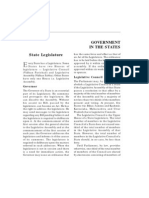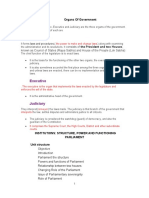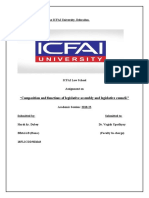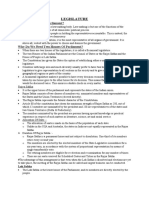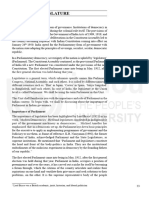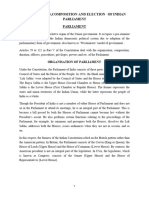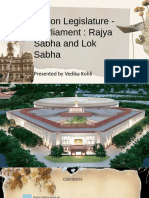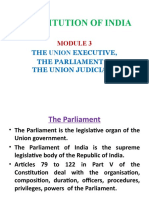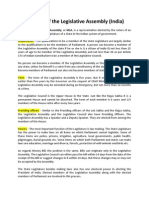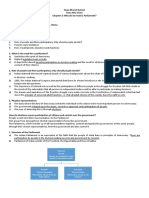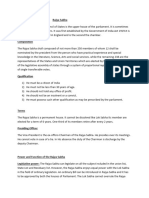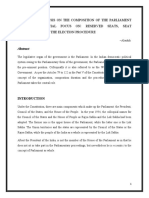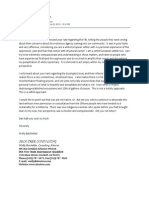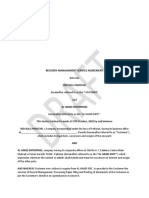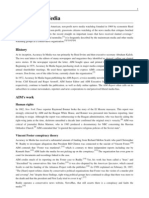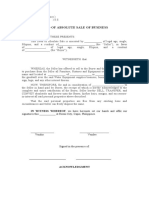Parliament & State Legislature
Parliament & State Legislature
Uploaded by
sushant kharbandaCopyright:
Available Formats
Parliament & State Legislature
Parliament & State Legislature
Uploaded by
sushant kharbandaOriginal Title
Copyright
Available Formats
Share this document
Did you find this document useful?
Is this content inappropriate?
Copyright:
Available Formats
Parliament & State Legislature
Parliament & State Legislature
Uploaded by
sushant kharbandaCopyright:
Available Formats
Parliament & State Legislature
Union Parliament State Legislatures
Mostly unicameral – only 6 states are
Bicameral
bicameral
Article 79 to122 in Part V of the Articles 168 to 212 in Part VI of the
Constitution Constitution
The Legislative Councils (LC) have only
advisory powers by and large.
They have lesser powers when it comes to law-
making.
If a bill is introduced in a House, and it
passes it, then the other House can: If a bill is introduced in the LC, which is
passed by it, and it goes on to the Assembly:
1. Pass the bill as it is.
2. Reject the bill altogether. 1. The Assembly rejects the bill.
3. Pass the bill with some 2. It passes the bill with some
modifications and return it to the modifications which are unacceptable
first House for reconsideration. to the LC.
4. Nothing is done to the bill for 6
months, which means both Houses In both the above cases, the bill comes to an
are in disagreement. end.
In this case, a joint sitting of both the However, if the bill originates in the Assembly,
Houses is convened and made, to break the and it is either rejected or passed with
constitutional deadlock. modifications not acceptable by the LC, it does
not come to an end.
Note: In the case of Money Bills, which are
to be introduced only in the Lok Sabha, the There is no provision for a joint sitting of
Rajya Sabha has restricted powers. the Council and the Assembly. In the case of
a disagreement, the decision of the Assembly is
deemed final.
Note: Money bills can originate only in the
Legislative Assembly.
Members: Legislative Assembly: Between 40
and 500
Members: Lok Sabha: 552 (Max.)
Legislative Council: Not more than one-third
Rajya Sabha: 250 (Max.)
of the membership of the State Legislative
Assembly, and cannot be under 40.
Election to the Legislative Councils:
Election to the Rajya Sabha:
Members are elected by five different
Members are elected by the elected
constituencies through a process of the single
members of the State Legislative
transferable vote system.
Assemblies by means of proportional
By Keshav Kant Sharma, CLC
representation by means of a single 1. ⅓ of the members are elected by the
transferable vote. local authorities’ representatives (Gram
Panchayats, Municipalities, Block
Parishads, etc.)
2. ⅓ of the members by the MLAs.
3. 1/12 of the members are elected by the
teachers (of secondary schools,
colleges, and universities) in the state.
4. 1/12 are elected by the graduates in the
state.
5. The remaining 1/6th are nominated by
the Governor from persons having
experience or knowledge in the fields of
science, art, literature, social service, or
cooperative movement.
The functions of the Parliament are provided for in the Indian Constitution in Chapter II, Part
V. You can also read more about the functions of the Indian Parliament in detail here.
At the state level, the legislature is composed of the Legislative Assembly, the Legislative
Council (only in 6 states currently), and the Governor of the State.
• In the Constitution, there are provisions for the creation of a second chamber (the
Legislative Council) for states which do not have one. There are also provisions for the
abolition of the Council for states. (Article 169).
• Currently, 6 states in India have the Legislative Council. They are:
o Maharashtra
o Karnataka
o Andhra Pradesh
o Telangana
o Uttar Pradesh
o Bihar
• There are proposals to abolish the Council in Andhra Pradesh.
• Until Article 370 was in place, Jammu & Kashmir also had a Legislative Council under
its own Constitution. Now, it is a Union Territory with a Legislative Assembly.
• Tamil Nadu abolished its Legislative Council (called Vidhan Parishad) in 1986.
By Keshav Kant Sharma, CLC
Composition of Parliament
The Parliament in India comprises the President of India, the Upper House i.e. Rajya Sabha
and the Lower House i.e. Lok Sabha.
Hindi names of both the houses, i.e. Rajya Sabha and Lok Sabha had been adopted by the
Upper House and the Lower House respectively.
The Constitution describes the structure of parliament in Article 79. It states that the Parliament
comprises of the President and the two houses i.e. the Lower House or House of People and
Upper house or Council of States.
To understand the functions served by the President, we can say that the post of president is
somewhat equivalent to the role and functions of the Queen or Crown in the United Kingdom.
Even though the President is a part of the legislature, he doesn’t sit in parliament.
However, a bill passed by houses can’t be made law without the assent of the President.
Now, let’s discuss the Upper house or Rajya Sabha.
The Rajya Sabha
Rajya Sabha is the Upper House of the Indian Parliament.
This house is permanent in nature as it can never be dissolved. This is because every member
elected to the Rajya Sabha serves for a term of 6 years and one-third of members do retire
biennially, while the other members continue their tenure. It’s like an election in different
batches.
Retired members are subject to re-election.
This house consists of 250 members out of which, 238 members are elected by means of a
single transferable vote. 12 members are nominated by the President on the advice of the
council of ministers.
The method of election of these members is listed in Article 80(1) of the Indian Constitution.
By Keshav Kant Sharma, CLC
It says that the members would be elected by the elected members of respective state assemblies
in accordance with proportionate representation of every state.
This provision thus reflects the federal nature of the Council of States, where every state is
represented proportionally.
However, the number of members representing each state varies from 1 to as large as 31 (for
Uttar Pradesh).
Article 84 of the Indian Constitution provides for the qualification to become a member of
Rajya Sabha, i.e. one must have the nationality of India, doesn’t holds any office of profit and
must have completed 30 years of age. Article 102 of the Indian Constitution provides for
conditions on which one can be disqualified from either of the houses. It says that one must be
disqualified as a member of the house if,
• he/she holds any office of profit;
• he/she is of unsound mind;
• he/she is discharged insolvent;
• he/she is not a citizen of India and has voluntarily accepted the nationality of other
nations;
• he/she is disqualified under any law made by the Parliament.
Chairperson and Deputy Chairperson of Rajya
Sabha
In Rajya Sabha, the Vice-President of India presides of its sessions and is ex-officio chairperson
of the house.
However, to take care of its day-to-day affairs, and to preside over the sessions in the absence
of the Chairperson, i.e. the Vice-President, a member of the house itself is chosen internally by
the Rajya Sabha as Deputy Chairperson of the house.
Position in other Countries
It’ll be an interesting task to look into other democratic systems if something like Rajya Sabha
or Upper House exists there too.
Most of the nation-states in the European Union have a council of states. And almost all of
them functions as a consultative or advisory body to the president or the government.
For example, the Belgian Council of States is a Judicial and advisory body, which assists legal
advisory in matters of draft bills to the executive.
While in China, the Chinese State Council happens to be the highest administrative body of the
country.
By Keshav Kant Sharma, CLC
In Portugal, the Portuguese State Council serves as an advisory body of the President of the
state.
In the United States, there is no such body resembling the functions that Rajya Sabha serves.
However, it has a bicameral legislature and is comprised of House of Representatives and the
Senate. Interestingly, the number of senators for each administrative unit is fixed, i.e. 2.
Let’s discuss the utility of Rajya Sabha and the need for the second house.
The utility of the Rajya Sabha
Regarding utility and need of a second chamber in the parliament, an extensive debate took
place in the constituent assembly while framing of the constitution.
Ultimately, it was agreed to adopt a bicameral system of legislature and thus the Rajya Sabha
was formed as the second chamber with a different method of election and different
composition altogether.
The utility of the Rajya Sabha can be understood by this hypothetical situation. Suppose, after
general elections, a single political party comes to a thumping majority in the lower house.
Now, having this majority, they can pass any bills or piece of legislation even if the same is
not fruitful to the people and democracy unless there is a system of check.
So, this second house serves as a safety valve and a system of check regarding all the functions
of the lower house.
The Lok Sabha
The provisions of Article 331 of the Indian Constitution provides for the existence of the house
of the people and shall consist of a maximum of 530 chosen members from different states, not
more than 20 members to be chosen from the Union Territories. If President feels that there is
a lack of representation of the Anglo-Indian Community in parliament he may nominate two
members of the Anglo-Indian Community.
Some seats are also reserved for the Scheduled Caste and Scheduled tribes communities
especially laid aside for them all over the country.
The representation is allocated to the states and the Union Territories according to the
Representation of the people Act passed by the Parliament of India in 1951.
The Lok Sabha, unless dissolved midway, continues its tenure for 5 years from the day of its
first meeting.
Territorial Constituencies
By Keshav Kant Sharma, CLC
As the members of the Lok Sabha are elected directly, it needs to have a proper division of the
country into smaller units.
And for this purpose, India is divided into small territorial constituencies.
These constituencies are sorted out in such a way so that each Indian state has an adequate
share of members in the house and is proportional to its population.
To keep this division democratic, the constituencies are carved out in such a way so that the
ratio of the number of representatives and the population of that particular constituency should
remain the same across all the constituencies.
Tenure of Lok Sabha
The members elected by Universal Adult Suffrage serve their offices for a tenure of five years.
However, if devoid of a popular majority, the government can fall and the house can dissolve
midway anytime before the completion of five years.
Qualification for Membership of Parliament
Qualifications necessary for becoming a member of parliament is provided in Article 84 of the
Indian Constitution.
Following are the qualifications:
• he/she should be a citizen of India.
• In the case of Upper House,i.e. Rajya Sabha, he/she should have completed at least 30
years of age and for Lower House,i.e. Lok Sabha, he/she should have completed 25
years of age.
• he/she need to comply with other such qualifications as prescribed in any law by the
Indian Parliament.
Now. let us take a look into grounds on which one can be disqualified as a Member of
Parliament.
Disqualification
Now, Article 102 of the Indian Constitution lays the grounds on which a legislator can be
disqualified as a member of the Parliament.
Those grounds are:
• If he/she holds any office of profit under the Government of India or any of the states;
• If he/she is declared of unsound mind by a Court;
• If he/she is an undischarged insolvent;
• If he/she is not a citizen of India anymore;
By Keshav Kant Sharma, CLC
• If he/she is disqualified by virtue of any law passed by the parliament of India.
Office of Profit
As it is a ground for disqualification as a member of Parliament, it is essential to understand
what exactly does the office of profit means.
Office of profit refers to any post or position under central or state government which fetches
salaries, bonuses, perks and other benefits to the individual.
However, the quantity of profit gained is irrelevant under this disqualification.
Under section 9 of Representation of people Act and Article 191(1)(a) of the Indian
Constitution, it is envisaged that no representative should bear any office of profit.
Disqualifications under the Representation
of Peoples Act
A member of parliament can also be disqualified under the Representation of Peoples Act,
1951. This act was passed by the Parliament under Article 327 of the Indian Constitution, which
provides for the procedure and the conduct to be followed during the election to Parliament
and state legislatures.
Following are the grounds:
• If he/she is convicted for indulging in corrupt practices during the election or any other
election-related offenses.
• If he/she is convicted under certain acts of Indian Penal Code, Unlawful Activities
Prevention Act, Prevention of Terrorism Act 2002, etc.
• If he/she is convicted under any law that results for at least two years of imprisonment
and will remain disqualified for a further 6 years after his release.
• If he/she is convicted under any law relating to drugs or dowry prevention.
• Dismissal from the government due to disloyalty or involvement in corrupt practices.
• If he/she fails to lodge their election expenses.
Disqualification on ground of defection
The need for an anti-defection law was felt in India when in 1967, one legislator from Haryana,
Gaya Lal, changed his party thrice in a single day. Also, the General Elections of 1967 saw a
great number of defections was seen as around 150 MPs flitted their political parties.
However, an act tackling such problems was passed by Parliament in the year 1985.
With 52nd amendment to Indian Constitution, provisions regarding disqualification of the basis
of defection were inserted in the 10th schedule of the Indian Constitution.
By Keshav Kant Sharma, CLC
As per the provisions, the members can be disqualified on the following grounds:
• When members of a political party don’t abide by his/her party leadership or voluntarily
resigns from the party.
• When members don’t votes or refrains from voting according to his/her party whip.
• An Independent member stands disqualified if he/she joins a political party.
• For nominated members, if he/she is not a member of any political party, he/she if want,
has to join a political party within 6 months of nomination or membership stands
canceled.
However, voluntarily giving up membership has quite a broader meaning. In the case of Ravi
Naik vs Union of India, giving up membership doesn’t necessarily mean resigning, but it can
also be inferred by the conduct of the member.
Now let’s look for which people have the authority to disqualify the members.
The chairman, in the case of Rajya Sabha and the Speaker, in the case of Lok Sabha has powers
to disqualify a member on grounds of defection.
And, regarding complaints of Speaker/Chairperson involved in defecation, a member elected
by the house itself will take necessary actions regarding the same.
This law also has some exceptions, specifically when political parties merge with some other
political party.
Vacation of seats
Now, the question comes in our mind is, what if a member vacates his seat?
And what are the grounds of vacation of seats?
So, to deal with such situations, our Constitution provides us with Article 101 in the Fifth part
of the Indian Constitution.
Thus, as envisaged under this Article, a member must vacate his/her seat if
• He/she is elected in both houses as this article clearly states that no person shall be
chosen as members in both the houses.
• He/she becomes a member of the Central legislature as well as a state legislature, then
he must vacate his seat in the house.
• He/she becomes subject to any of the disqualifications mentioned by Parliament
• He/she, without permission of the speaker, is absent from the house for consecutive 60
days
And, after a seat is vacated in either of legislative houses, polls are conducted to fill the
vacancy.
Speaker and Deputy Speaker of Lok Sabha
By Keshav Kant Sharma, CLC
To preside over sessions of the house, the Speaker of the Lok Sabha is elected among the sitting
members of the house. He/she is generally elected in the first meeting of the Lok Sabha and
serves a tenure of 5 years along with that particular Lok Sabha. And as normally practiced, the
Speaker is a member of the ruling party or alliance.
Regarding the election of the Speaker, sitting MPs proposes names and the same are notified
to the President of India.
Then a date for the election is notified.
Now, if only one name is proposed by the MPs, no formal voting happens but, in a case where
a proposal for more than one name shows up, a division vote is organized and the Speaker is
chosen accordingly.
Inter alia (among other things), one of the main functions of a Speaker is to decide upon
whether a bill is a money bill or not.
His/her function also includes maintaining decorum and discipline in the house and punishing
those who are not complying with his guidelines. Also, in the order of precedence, he/she is
ranked 6th, parallel to the Chief Justice of India.
According to Article 94 and Article 96 of the Indian Constitution, a Speaker can be removed
by a resolution passed with an effective majority, i.e More the 50% of the members of the
house.
He/she can also be removed according to The Representation of the People Act and when a bill
is wrongly certified as a money bill by the Speaker.
The Deputy Speaker of the Lok Sabha serves as a Number-Two, who in the absence of the
Speaker carries forward his roles and functions.
He/she also has a tenure of 5 years and can leave the post midway if he/she ceases to be a
member of parliament.
Sessions of Parliament
Now coming to Sessions of the Parliament, let’s first understand what exactly a session is.
So, whenever either of the houses meets for the conduct of its business, for the period it meets,
is called a session.
With not more than a 6-months gap, the president can summon either of the houses for
conducting a session.
Thus, the Parliament must necessarily meet at least two times a year.
As per convention, three sessions are conducted by the Indian Parliament in a year:
• Budget Session between February and May.
By Keshav Kant Sharma, CLC
• Monsoon Session between July and September.
• Winter Session between November and December.
Prorogation
Prorogation of the house essentially means termination of a session of the house.
The notice of prorogation is issued by the Speaker or the Chairperson of the House. After a
session is ended, the presiding officer adjourns the house sine die, i.e with no appointed date
for resuming the house and then after a few days, the notice is issued.
However, houses of the Parliament can also be adjourned or prorogued when in session.
This is provided under Article 85(2) of the Indian Constitution.
Dissolution
The power to dissolve the Lok Sabha is placed with the President of India in accordance with
Article 85 of the Indian Constitution.
In two cases, dissolution of the Lok Sabha is possible:
• When the term of the Lok Sabha, i.e 5 years complete and is dissolved by the leader of
the ruling party.
• When the government loses the majority and floor test is about to happen, in that case,
the president can dissolve the house.
And, it is completely different from adjournment or prorogation as Dissolution means the end
of the term of that particular Lok Sabha.
Effect of Dissolution on the business pending
in the House
Articles 107 and 108 of the Indian Constitution deals with these situations.
It states that whenever the Lok Sabha is dissolved, be it after completing its whole term or
midway, all the business, which includes bills, notices, petitions, motions, etc, do lapses.
When a new Lok Sabha is elected and it begins with its sittings, all the motions, bills and
notices need re-introduction in the house.
Functions of the Parliament
From the gist of what our constitution provides, we may infer that Parliament is an institution
which exerts an amalgamation of executive and legislative authority.
By Keshav Kant Sharma, CLC
There are certain functions that the Parliament of India serves.
Following are the functions:
• Legislation
The basic function which the Parliament serves is of legislating.
Legislating essentially means making laws and provisions for the smooth functioning of the
government and the nation at large.
This function is embedded in Article 107-108 of the Indian Constitution.
Raison d’etre of this function is the realization of the constitutional objective of India as a
welfare state.
• Providing the cabinet
Another basic function of the parliament is providing the cabinet, which stands responsible for
the Parliament itself and provides the proper aide to the President.
However, the cabinet is accountable only towards the Lok Sabha, it may consist of members
from Rajya Sabha too.
• Control of the cabinet
It is a function of the parliament to see if the cabinet is able to maintain its trust through the
majority of the ruling party, i.e. if the ruling party loses trust or majority, the cabinet must have
to resign.
The same is expressed in Article 75(3) of the Indian Constitution.
• Criticism and evaluation of the cabinet
Criticizing and evaluating the cabinet and the ministers is the foremost function of the
parliament.
As the cabinet is responsible for the Parliament, evaluation of the actions and decisions of the
cabinet must be done by other members. This serves as a safety valve and provides for a system
of checks.
It bars the government to act in a dictatorial way while avoiding the public interest. This
function can be discharged by both the houses of the parliament.
• Financial control
The legislature has exclusive authority to allocate expenditures and finances for public services
and other affairs. It also provides with the measures to be taken for raising revenue and receipts
to be appropriated according to needs.
By Keshav Kant Sharma, CLC
These authorities are wielded in such a way that keeps the democracy basic essence of our
constitution alive.
Ordinary Bill
Any bill, which is proposed in the Parliament is an ordinary bill except those which get the
certificate of money bill by the Speaker of the Lok Sabha.
It can be proposed/introduced in either of the houses, i.e. Rajya Sabha or Lok Sabha.
It can be introduced by a minister as well as a private member and those introduced by a private
member is known as a private member bill.
For introducing such bills, the president’s recommendation is not required and necessary.
Unlike the money bill, these bills can be rejected or amended even in the Rajya Sabha and the
Upper House can detain such bills for a period of up to 6 months, not further than that.
Also, if such bills were defeated in the Lok Sabha, it may lead to the resignation of the whole
government if introduced by a member.
Once sent for approval of the President, these bills can be accepted, rejected or returned for
reconsideration to the house.
Joint Sitting of Houses
In case of a deadlock between both, the houses of parliament regarding the passing of a bill,
the President of India may summon a joint sitting of both the houses.
The joint sitting of both the houses is presided over by the Speaker of the Lok Sabha and in his
absence, the Deputy Speaker of the Lok Sabha discharges this function.
Article 108 of the Indian Constitution provides provisions for this mechanism which breaks
the deadlock between both the houses.
According to this Article, a joint session can be called upon only if:
• A bill, after being passed out in one house, and the other house rejects it;
• One of the houses doesn’t accept the amendments passed by the other house;
• When 6 months elapse, and the other house doesn’t pass the bill.
There are some exceptions available to the Joint Sitting of the Houses:
• Money Bill: According to the Constitution, Money bills only require approval from the
Lok Sabha, thus, in case of money bill the situation arises for a Joint Sitting of the
Houses.
By Keshav Kant Sharma, CLC
• Constitutional Amendment Bills: A Constitutional amendment bill can be passed on
through a 2/3rd majority of both the houses and doesn’t have a provision for Joint
Sittings in case of disagreement between the houses.
President’s Assent
According to Article 111 of the Indian Constitution, when a bill is passed by both the houses
of the Parliament it must be presented to the President and he/she needs to declare that he/she
assents to the bill or withholds assent.
Money Bill
According to Article 110 of the Indian Constitution, a bill can be defined as a money bill if it
deals with imposition, abolition, alteration or regulation of any taxes and such bills can only be
introduced in the Lok Sabha and only by a member having a ministerial portfolio.
It can only be introduced on the recommendation of the president. Also, it requires certification
of the Lok Sabha Speaker, when transferred to the Rajya Sabha.
If this bill is defeated in the Lok Sabha, the entire cabinet has to resign, and also, it can’t be
returned for review by the President.
Financial Bills
Financial bills are quite similar to those of Money bills.
To understand what a Financial bill is, we may assert that any such bill which carries some of
the provisions of Article 110 of the Indian Constitution relating to expenditure and taxation is
a financial bill.
Such bills are introduced only in Lok Sabha on the recommendation of the President and it
needs to be passed in both the houses.
Now, the question which arises is what are the differences between a Money Bill and a
Financial Bill?
To understand easily, we may say that Money Bills are a kind of subset of Financial Bills, i.e.
all the Money Bills are Financial bills but the same is not true vice-versa.
By Keshav Kant Sharma, CLC
The distinction between Money Bills, Financial
Bills and Bills involving expenditures
The major difference between a Money Bill and a Financial Bill is that Rajya Sabha can’t
amend the Money bill but this is not the case with the Financial Bills.
Also, a Money Bill strictly deals only with the provisions as laid down in Article 110 of the
Indian Constitution while a Financial bill can also cover other provisions than taxation and
expenditure.
A Money bill needs certification from the Speaker of the Lower House, while a Financial Bill
doesn’t need any such certification.
Annual Financial Statement (Budget)
The Annual Financial Statement or as often called, budget is an important document dealing
with the finances of a nation.
Provisions relating to Budget are discussed in Article 112 of the Indian Constitution.
The budget is presented in such a way that expenditure and receipts regarding fiscal and deficits
of the current year, the previous year and the year for which budget is presented.
The Annual Financial Statement consists of three parts i.e Consolidated fund of India, Public
Account of India and Contingency Fund of India.
It also includes an account of loans advanced by the government or the loans to be recovered
by it including borrowing from Reserve Bank of India.
By Keshav Kant Sharma, CLC
Discussion and voting on Budget
So, after a budget is proposed by the Finance Minister, it is followed by Extensive discussion
in the house and lastly, voting is done.
The voting is done on the Demands of Grants.
Now, what are the Demands of Grants?
Demands of Grants basically mean expected spending by a particular department or ministry.
Now after this voting is done, the parliament happens to be in recess.
After the recess is over, then all the standing committees submit their respect reports followed
by discussion and voting.
This is all how discussion and voting are done during the tabling of the budget in the budget
session of parliament.
Appropriation Bills
After the discussions are over on budget and expenses, then an appropriation bill is tabled by
the government if it intends to withdraw funds from the Consolidated Fund of India.
This is done when the government wants to withdraw the funds for expanding and meeting the
expenditure.
It must be noted that this bill is introduced only in the Lok Sabha.
Supplementary Additional or Excess Grants
Excess Grants are granted to the Government when the amount authorized for a particular
service by virtue of a law is found to be insufficient.
These funds are granted by the President of India.
By Keshav Kant Sharma, CLC
The Constitution of India discusses this in Article 115 of part V.
Also, when the actual expenditure incurred on a certain service or scheme is more than what
was allocated for the same, then the Comptroller and Auditor General takes action and brings
notice to the Parliament.
After that, the respective ministers raise demand for excess grant and then the procedure
regarding the same is followed by voting and discussion.
General Rules of Procedure
The General rules of procedure deal with the procedure and conduct to be followed in both the
houses. It lays down the parliamentary procedures and rules according to which the parliament
must function.
It also lay down process according to which the parliament must table and pass a bill or other
kinds of legislation. It also deals with the structure and function of the standing committees on
different matters
These rules are fundamental for the genuine working and functioning of the Parliament.
Parliamentary Control over Financial Matters
Financial matters in India are largely controlled by the Parliament. This control includes control
over revenue matters and expenditure related issues.
As stated in the Constitution in Article 265, no tax can be collected or levied by the executive
authorities without any law supporting it. So, if tax is imposed upon anyone without having
legislative backing, then the person can go to court for redressal.
As Parliament holds control over the Consolidated Fund of India, its control over the
expenditure is pivotal. As the Consolidated fund of India is the reservoir of all the expenses
and finances of India, the parliament thus exerts full control over expenditure.
Parliamentary Committees
Parliamentary committees are made to ease the scrutinizing of the legislative and other matters
of the Parliament. Broadly, these committees can be classified as Standing committees, which
are permanent and ad hoc committees that are temporary and are constituted according to the
need.
Among the standing committees, the estimates committee, public accounts committee and
public undertakings committees are the major ones.
However, 17 different standing committees for different departments are also constituted for
easing the business. Some such committees are committees of petitions, a committee of
privileges, committee on papers laid, etc.
By Keshav Kant Sharma, CLC
While the Ad Hoc committees are more of temporary committees. These committees address
matters like committees on five-year plans, the joint committee on Bofors agreement,
committee on food management in the parliament, etc.
Language to be used in Parliament
The official languages of India can be used in the Parliament of India, i.e. Hindi and English.
Article 343 of the Indian Constitution provides for the official language of India. However, the
members can use any of the scheduled languages while in discussion or debate.
Restriction on discussion in Parliament
To keep the doctrine of Separation of Power intact, the Constitution of India forbids the
Parliament to legislate and discuss certain matters.
Article 121 discusses these provisions.
This includes any discussion regarding the conduct of the judges of the Supreme Court or
judges of any of the High Courts. However, the discussion can happen in the question of the
impeachment of a judge.
Courts not to inquire into proceedings of
Parliament
This may be seen as vice-versa provision of Article 121. Article 122 of the Constitution
provides for the provision that the courts can not inquire into the proceedings of the legislation.
Also, any officer or member of the Parliament while exercising his powers endowed upon
him/her by parliament is not subject to the jurisdiction of any of the Courts.
By Keshav Kant Sharma, CLC
The Comptroller and Auditor-General of India
In the words of the architect of the Indian Constitution, Dr.B.R. Ambedkar, the Comptroller
and Auditor-General of India is one of the most important officers which the Constitution
provides for as he/she looks after finances and expenditure by the Parliament.
CAG of India is not accountable towards anyone but the public as he/she looks after the public
purse of the nation.
Article 148 of the Constitution talks about the appointment of CAG and its oath. He/she also
derives authority from The Comptroller and Auditor General’s (Duties, Powers and Conditions
of Service) Act, 1971.
Duties and Powers
The major duties and functions of the CAG, according to the Indian Constitution are:
• All the accounts of Union Government and State Governments come under the ambit
of Audit by the CAG.
• All the expenditures from the Contingency Fund and the Public Account are also
audited by the CAG.
• CAG also audits all the expenditures and receipts by all the Government authorities and
Undertakings.
• CAG can also audit account of the local bodies on request of the President or the
Governor.
• CAG also acts as a guide to the Public Accounts Committee in Parliament.
▪ Sessions of Parliament:
o The summoning of Parliament is specified in Article 85 of the Constitution.
o The power to convene a session of Parliament rests with the Government.
The decision is taken by the Cabinet Committee on Parliamentary Affairs
which is formalised by the President, in whose name MPs are summoned to
meet for a session.
o India does not have a fixed parliamentary calendar. By convention (i.e. not
provided by the Constitution), Parliament meets for three sessions in a year.
• The longest, Budget Session (1st session), starts towards the end of
January, and concludes by the end of April or first week of May.
The session has a recess so that Parliamentary Committees can discuss
the budgetary proposals.
• The second session is the three-week Monsoon Session, which
usually begins in July and finishes in August.
• Winter Session (3rd session), is held from November to December.
▪ Summoning of Parliament:
o Summoning is the process of calling all members of the Parliament to meet.
The President summons each House of the Parliament from time to time. The
By Keshav Kant Sharma, CLC
gap between two sessions of the Parliament cannot exceed 6 months, which
means the Parliament meets at least two times in one year.
▪ Adjournment:
o Adjournment terminates the sitting of the House which meets again at the
time appointed for the next sitting. The postponement may be for a specified
time such as hours, days or weeks. If the meeting is terminated without any
definite time/ date fixed for the next meeting, it is called Adjournment sine
die.
▪ Prorogation:
o Prorogation is the end of a session. A prorogation puts an end to a session.
The time between the Prorogation and reassembly is called Recess.
Prorogation is the end of session and not the dissolution of the house (in case
of Lok Sabha, as Rajya Sabha does not dissolve).
▪ Quorum:
o Quorum refers to the minimum number of the members required to be
present for conducting a meeting of the house. The Constitution has fixed one-
tenth strength as quorum for both Lok Sabha and Rajya Sabha. Thus, to
conduct a sitting of Lok Sabha, there should be at least 55 members present
while to conduct a sitting of Rajya Sabha, there should be at least 25
members present.
Legislative Council
▪ Base For Formation
o India has a bicameral system of legislature. Just as Parliament has two
Houses, the states can also have a Legislative Council in addition to the
Legislative Assembly through Article 169 of the Constitution.
▪ Six States having a Legislative Council: Andhra Pradesh, Telangana, Uttar Pradesh,
Bihar, Maharashtra, Karnataka.
o Recently, the Jammu & Kashmir Legislative Council has been abolished
through the J&K Reorganisation Bill, 2019, which reduced the State of J&K to
the Union Territories of J&K and Ladakh.
▪ Abolition or Creation - Article 169
o The Parliament can abolish a legislative council (where it already exists) or
create it (where it does not exist) by a simple majority, that is, a majority of
the members of each House present and voting, if the legislative assembly of
the concerned state, by a special majority, passes a resolution to that effect.
o Special majority implies
• A majority of the total membership of the assembly and
• A majority of not less than two-thirds of the members of the assembly
present and voting.
▪ Composition
o Under Article 171 of the Constitution, the Legislative Council of a state shall
not have more than one-third of the total strength of the State Assembly, and
not less than 40 members.
o Like the Rajya Sabha, the legislative council is a continuing chamber, that is,
it is a permanent body and is not subject to dissolution. The tenure of a
Member of the Legislative Council (MLC) is six years, with one-third of
the members retiring every two years.
▪ Manner of Election
By Keshav Kant Sharma, CLC
o One-third of the MLCs are elected by the state’s MLAs,
o Another 1/3rd by a special electorate comprising sitting members of local
governments such as municipalities and district boards,
o 1/12th by an electorate of teachers and another 1/12th by registered graduates.
o The remaining members are appointed by the Governor for distinguished
services in various fields namely, literature, science, art, cooperative
movement and social service.
▪ LC vis-à-vis Rajya Sabha
o The legislative power of the Councils are limited. Unlike Rajya Sabha which
has substantial powers to shape non-financial legislation, Legislative Councils
lack a constitutional mandate to do so.
o Assemblies can override suggestions/amendments made to legislation by the
Council.
o Again, unlike Rajya Sabha MPs, MLCs cannot vote in elections for the
President and Vice President. The Vice President is the Rajya Sabha
Chairperson while a member from the Council itself is chosen as the Council
Chairperson.
▪ Arguments in Favour
o A Legislative Council can help check hasty actions by the directly elected
House.
o The Legislative Council also enables non-elected individuals to contribute to
the legislative process.
▪ Arguments Against
o Legislative Council can delay legislation.
o It can also be used to park leaders who have not been able to win an election.
By Keshav Kant Sharma, CLC
You might also like
- 5 Sample Position PaperDocument3 pages5 Sample Position Papersweetlaogirl89% (56)
- Ryan O'Neill Criminal AffidavitDocument6 pagesRyan O'Neill Criminal AffidavitNational Content DeskNo ratings yet
- Parliament and State LegislatureDocument3 pagesParliament and State LegislatureRizwan FarooquiNo ratings yet
- STATE LEGISLATURE ProjectDocument7 pagesSTATE LEGISLATURE Projectalhankunal0% (1)
- State LegislatureDocument7 pagesState LegislaturethatsafreenNo ratings yet
- Unit - II EnglishDocument17 pagesUnit - II EnglishRavindra BaghelNo ratings yet
- Government in The States State LegislatureDocument12 pagesGovernment in The States State LegislaturegrsrikNo ratings yet
- ParliamentDocument14 pagesParliamentMOHD FAIZAN ALINo ratings yet
- CSE Class 10 Board Exam Questions and AnswersDocument64 pagesCSE Class 10 Board Exam Questions and AnswersRanjit SinghNo ratings yet
- Module IV - Parliament and Organs of GovernmentDocument19 pagesModule IV - Parliament and Organs of GovernmentKARTHIK MNo ratings yet
- Parliament of IndiaDocument15 pagesParliament of IndiasruthymolsNo ratings yet
- Safari - 27-Nov-2023 at 4:14 PMDocument1 pageSafari - 27-Nov-2023 at 4:14 PMrishabh1907singhNo ratings yet
- IC- Unit 2Document14 pagesIC- Unit 2Kavya ANo ratings yet
- Ashu - The Union LegislatureDocument6 pagesAshu - The Union LegislaturesanyacamaterialNo ratings yet
- Constitution@2Document14 pagesConstitution@2Harsh DubeyNo ratings yet
- Rajya Sabha: Functions and Position of The Rajya Sabha!Document7 pagesRajya Sabha: Functions and Position of The Rajya Sabha!SACHIN DHIRAANNo ratings yet
- State Legislature - Article 168 - 212: Bicameral and Unicameral StatesDocument5 pagesState Legislature - Article 168 - 212: Bicameral and Unicameral StatesKirti KanaujiyaNo ratings yet
- Polity Ebook IIDocument22 pagesPolity Ebook IIAjinkyaNo ratings yet
- E-Note 3602 Content Document 20230102055357PMDocument36 pagesE-Note 3602 Content Document 20230102055357PMAshish ShankerNo ratings yet
- ParliamentDocument17 pagesParliamentPardeep SinghNo ratings yet
- TianaDocument7 pagesTianaCHRISTIANA SUNBABAARANo ratings yet
- State Legislature and Union Territories 98Document6 pagesState Legislature and Union Territories 98Arun GurjarNo ratings yet
- Parliament 1Document81 pagesParliament 1Abhimanyu RathodNo ratings yet
- LEGISLATUREDocument4 pagesLEGISLATUREEvaNo ratings yet
- Speaker of The Lok SabhaDocument3 pagesSpeaker of The Lok SabhaSoumil BoradiaNo ratings yet
- The Legislative Council: State LegislatureDocument4 pagesThe Legislative Council: State LegislatureAbhijith JosephNo ratings yet
- Module 2Document56 pagesModule 2you • were • trolledNo ratings yet
- La Martiniere Girls' College: Class Viii AssignmentDocument12 pagesLa Martiniere Girls' College: Class Viii AssignmentPalakNo ratings yet
- LegislatureDocument11 pagesLegislatureakshataryansteamNo ratings yet
- About ParliamentDocument4 pagesAbout Parliamentanshita goyalNo ratings yet
- Relation Between Lok Sabha and Rajya SabhaDocument3 pagesRelation Between Lok Sabha and Rajya SabhaNikita kunduNo ratings yet
- State Legislature: Vidhan SabhaDocument3 pagesState Legislature: Vidhan SabhaCHANDANA .MNo ratings yet
- Unit - 2 CoiDocument17 pagesUnit - 2 Coivarshneytanisha766No ratings yet
- Unit 2Document24 pagesUnit 2sachinyadavv13No ratings yet
- An Us Heel 4Document5 pagesAn Us Heel 4jenniferrasquinhaNo ratings yet
- Indian ParliamentDocument6 pagesIndian Parliamentananda214No ratings yet
- Week 4 MergedDocument64 pagesWeek 4 Mergedrahul273gamingNo ratings yet
- Union Legislature- ParliamentDocument75 pagesUnion Legislature- Parliamentvedikakohli171028No ratings yet
- Why Do We Need A ParliamentDocument4 pagesWhy Do We Need A ParliamentsangwannakshatraNo ratings yet
- Complete Constituion Notes of Unit 2,3 and 4Document87 pagesComplete Constituion Notes of Unit 2,3 and 4Jitendra SinghNo ratings yet
- COI MODULE 3 PPT 2 KtuDocument9 pagesCOI MODULE 3 PPT 2 Kturain MCNo ratings yet
- Parliament of IndiaDocument73 pagesParliament of IndiaKj RajuNo ratings yet
- Union LegislatureDocument29 pagesUnion Legislatureaaravkumar2809No ratings yet
- Constitutional Law ParliamentDocument26 pagesConstitutional Law ParliamentAshwina NamtaNo ratings yet
- Member of The Legislative AssemblyDocument3 pagesMember of The Legislative Assemblyಸುರೇಶ್ ಎನ್ ರಂಗನಾಥ್No ratings yet
- Chapter 3 - ParliamentDocument3 pagesChapter 3 - ParliamentDivanshi ShakyaNo ratings yet
- State Legislature: Educator-Abanish KumarDocument18 pagesState Legislature: Educator-Abanish KumarRohan PatilNo ratings yet
- Mains Master Notes Parliament and State Legislatures Lyst6972Document42 pagesMains Master Notes Parliament and State Legislatures Lyst6972abijeetNo ratings yet
- The Union LegislatureDocument4 pagesThe Union LegislatureSukti Basu PaulNo ratings yet
- COI - Unit 3,4Document9 pagesCOI - Unit 3,4LuckyNo ratings yet
- Cip Notes Unit 4-NewDocument10 pagesCip Notes Unit 4-Newhariharanv2655No ratings yet
- The Parliament of IndiaDocument17 pagesThe Parliament of IndiaAbhijeet BhosaleNo ratings yet
- Parliament-Organs, SovereigntyDocument32 pagesParliament-Organs, SovereigntySrijana BhardwajNo ratings yet
- Rajya SabhaDocument3 pagesRajya Sabhasmex48179No ratings yet
- Union LegislatureDocument6 pagesUnion Legislaturemamta sehrawatNo ratings yet
- The Indian ParliamentDocument4 pagesThe Indian ParliamentramunagatiNo ratings yet
- A Critical Analysis On The Composition of The Parliament Wiith The Special Focus On: Reserved Seats, Seat Distribution and The Election ProcedureDocument9 pagesA Critical Analysis On The Composition of The Parliament Wiith The Special Focus On: Reserved Seats, Seat Distribution and The Election ProcedurePrasamNo ratings yet
- Constitution of India, Law & Engineering: Assistant Professor Kiet School of ManagementDocument90 pagesConstitution of India, Law & Engineering: Assistant Professor Kiet School of ManagementAASTHA KIETNo ratings yet
- Composition of ParliamentDocument9 pagesComposition of ParliamentankitadbrmishraNo ratings yet
- By Sheo Kumar, TGT (SST), K.V. Danapur Cantt. (S.S)Document21 pagesBy Sheo Kumar, TGT (SST), K.V. Danapur Cantt. (S.S)shiv shankarNo ratings yet
- TTR SpringfieldDocument18 pagesTTR SpringfieldThomas LeiversNo ratings yet
- Daily Mass LyricsDocument3 pagesDaily Mass LyricsmareneashazoehNo ratings yet
- Rhino Holding DeedsDocument11 pagesRhino Holding DeedsjulianglovertvNo ratings yet
- Can CouldDocument2 pagesCan CouldMoño RockjalesNo ratings yet
- REPUBLIC OF THE PHILIPPINES vs. THE HONORABLE ANIANO A. DESIERTODocument2 pagesREPUBLIC OF THE PHILIPPINES vs. THE HONORABLE ANIANO A. DESIERTOzacNo ratings yet
- Coll. - Tips and Tricks For PLABDocument174 pagesColl. - Tips and Tricks For PLABdrshekarforyouNo ratings yet
- Korea Under Japanese RuleDocument6 pagesKorea Under Japanese RuleLaraNo ratings yet
- Tripod Com Paracels74 HoangsahaichienDocument72 pagesTripod Com Paracels74 Hoangsahaichienapi-3707213No ratings yet
- MCF CC Email CoversheetDocument2 pagesMCF CC Email Coversheetnathaniel avanceñaNo ratings yet
- O Level Islamiat NotesDocument12 pagesO Level Islamiat NotesSyed Khayyam Shah101100% (3)
- Sexuality and Its Disorders - 1Document21 pagesSexuality and Its Disorders - 1Adepeju Adedokun AjayiNo ratings yet
- Dalziel, Nigel MacKenzie, John M - The Encyclopedia of Empire - Bulgarian Medieval Empire (First and Second)Document6 pagesDalziel, Nigel MacKenzie, John M - The Encyclopedia of Empire - Bulgarian Medieval Empire (First and Second)ddNo ratings yet
- 04 Chapter 4 NotesDocument10 pages04 Chapter 4 NotesyukkwanchuiNo ratings yet
- State Liability For Tort Committed by Public ServantDocument7 pagesState Liability For Tort Committed by Public ServantbhumijaNo ratings yet
- Knud HolmboeDocument3 pagesKnud HolmboeUvais AhamedNo ratings yet
- Kalb Responsive Records - 9852 PDFDocument427 pagesKalb Responsive Records - 9852 PDFRecordTrac - City of OaklandNo ratings yet
- 7 ForgivenessDocument5 pages7 ForgivenessMARIA FERNANDA ACHAYA ORMEÑONo ratings yet
- Comment K.A.Abbas Vs Union of IndiaDocument8 pagesComment K.A.Abbas Vs Union of IndiaRuksana ChikodeNo ratings yet
- Furusawa Vs Sec of LaborDocument6 pagesFurusawa Vs Sec of LaborMp CasNo ratings yet
- LUSOC - Desistance - Parojinog CaseDocument4 pagesLUSOC - Desistance - Parojinog CaseAldrin Christian A. LusocNo ratings yet
- Topic-Types of Cyber Crime Submitted To: Ms. Mahima Dabas Submitted By: Ashish Rathi Roll No. 170118546Document11 pagesTopic-Types of Cyber Crime Submitted To: Ms. Mahima Dabas Submitted By: Ashish Rathi Roll No. 170118546SANSKRITINo ratings yet
- Section 16 - Right To Speedy Disposition of Cases Padua vs. Ericta (G.R. No. L-38570, May 24, 1988) FactsDocument8 pagesSection 16 - Right To Speedy Disposition of Cases Padua vs. Ericta (G.R. No. L-38570, May 24, 1988) FactsKiko CorpuzNo ratings yet
- Agreement For The Record Management Red BullDocument8 pagesAgreement For The Record Management Red BullMUHAMMAD AZAMNo ratings yet
- Motivation Letter OCPDocument2 pagesMotivation Letter OCPLaelatul FitriNo ratings yet
- Rubrico v. Macapagal-ArroyoDocument2 pagesRubrico v. Macapagal-ArroyoAgus DiazNo ratings yet
- Accuracy in MediaDocument4 pagesAccuracy in MediaMichael GreenNo ratings yet
- Sale of BusinessDocument2 pagesSale of BusinessMarvin Rhick BulanNo ratings yet
- One More TimeDocument3 pagesOne More TimecutekekaNo ratings yet







